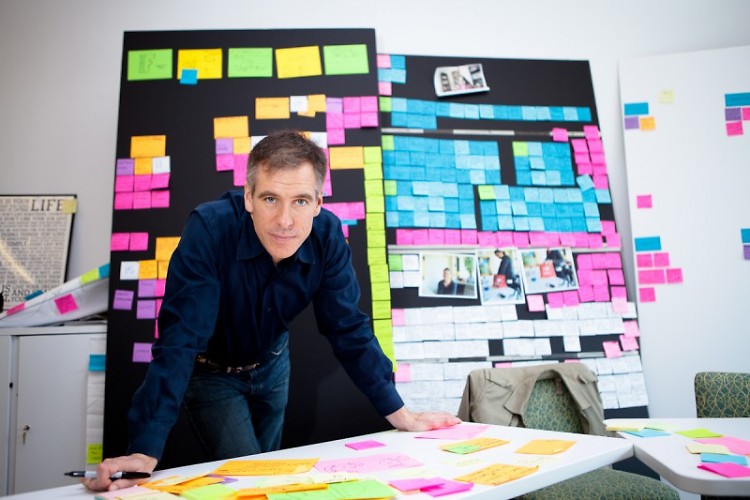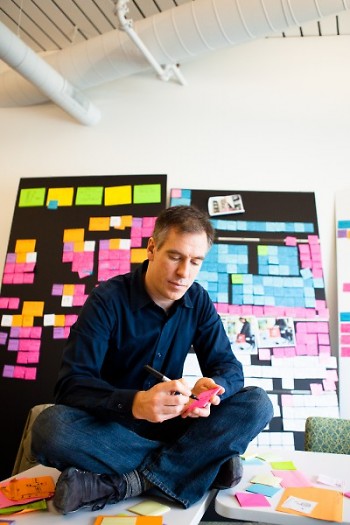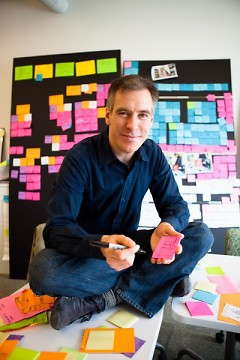Within a few minutes of meeting Seth Starner, it becomes clear he’s not the kind of guy who sits in one place for very long. It may be his bright blue eyes or the way he gestures in continuous motion as he speaks, but his excitement for innovation and design is bound to rub off.
Starner is a manager for business innovations at Amway where he’s worked for the past 10 years. The group focuses on "understanding human behavior, trends, and how we can evolve our business to be relevant in the coming decades,” he said.
At GRid70, a collaborative work space shared by four of Grand Rapid’s major corporations, Starner is surrounded by black foam boards about nine feet tall covered in hundreds and hundreds of multicolored sticky notes.
Starner props up one of the boards displaying a few 8x10 photos of a woman. Notes about her life fill up the remaining space and are organized under categories such as journey, occupation, motivation, choice logics and network. Starner jokes about his surprisingly nice handwriting as he sits cross-legged on top of a table and explains that much of his work is actually storytelling. He travels around the world learning about people’s lives with the goal of helping the business stay relevant to them.
“That was Germany,” Starner says as he walks around the room, moving other gigantic boards. “I’ve got Malaysia over here somewhere.”
Starner creates a lot of these large scale representations to help people see and make connections. He also creates prototypes whenever possible, like the full-size grocery store checkout made from cardboard in the hallway. It is also, not surprisingly, covered in sticky notes.
“It’s my strong belief that you have to visualize and make tangible new ideas because words just aren’t adequate,” he said.
Businesses try to understand the world from their own point of view, whereas “a designer, hopefully, is trying to understand the world from someone else’s point of view and then how the business can serve them. It’s a very different thing.”
Starner considered environmental education and international law before deciding to study Latin American economics and politics. He went to college in Central America for three years before finishing his undergraduate degree at the University of Michigan. Some of his past jobs included interning at a law firm dealing with international human rights and working for a truth commission in El Salvador, but Starner realized that trying to create something new would be more fulfilling.
“The common theme there was just an interest in understanding how people think, how people behave… how people interpret things,” he said.
This interest eventually led him to consulting in consumer insights back in the U.S., but it became frustrating to not get to see his ideas come to fruition. Then five years ago, he got the opportunity to join Amway’s business innovations team as one of the first members. Starner is now also pursuing a master’s degree in design methods through the Illinois Institute of Technology’s Institute of Design.
“The willingness to experiment is a key skill not only for success, but actually I think for happiness,” Starner said, regarding the number of career choices these days.
One of Starner’s innovations at Amway is called live model testing, which tests an idea on a small scale with real people as a way to gather data. When the company wanted to create a business in Africa that geared to help women living on three dollars a day or less improve their livelihood, double their income and provide useful products, they had little idea how to begin.
“You can’t just take things from the United States and expect them to work in Africa. Let alone on a different socioeconomic level,” Starner said. “They live in a very different reality.”
So Starner went to Africa and helped start a small business with 30 women.
“Live model testing is a way that we go from the design stage to the business stage and bridge a prototype or hypothesis to the reality,” he said. “Most companies want a 300 million dollar idea and they want it in a year,” but live model testing is done on a small scale so as to manage risk.
“Failure is called learning if you do it right,” he said. “And if you’re very analytical about learning then every failure is a way to know what not to do next time. Understanding how you got there and where you went is the value of it.”
Starner often finds inspiration walking through the park or the art museum at lunch time while letting his mind wander.
“Showers aren’t the place for me,” he said, laughing, but art helps him make connections he wouldn’t otherwise make.
“Artists are usually on the forefront of thinking about things in a different way,” he said.
When Starner travels, he brings home stamps from other countries for his two kids, who now have an extensive collection. He enjoys traveling, but also likes coming home to Grand Rapids. He’s interested in the new developments happening in the city and works with the Keller Futures Center and The Geek Group.
“I want Grand Rapids to be a hub of innovation,” he said. However, “it’s a mistake for us to try to copy other communities… We have our own personality, our own history, our own way of doing things.”
Starner suggests that others with innovative ideas go out and create, show people a model and then use the data to move forward. And, he says, be wary of past success.
“Success is its own barrier in the sense that once you’ve found a formula for success it’s pretty hard to change,” Starner said. “Innovation by its nature suggests that you have to start over. A lot of people don’t want to do that.” The world is changing rapidly and so, explains Starner, it’s necessary to continue changing to stay relevant.
“Design is basically anyone who wants to change the world from what it is to what it can be,” Starner said, “Anyone can be a designer.”
The Rapidian, a program of the 501(c)3 nonprofit Community Media Center, relies on the community’s support to help cover the cost of training reporters and publishing content.
We need your help.
If each of our readers and content creators who values this community platform help support its creation and maintenance, The Rapidian can continue to educate and facilitate a conversation around issues for years to come.
Please support The Rapidian and make a contribution today.



